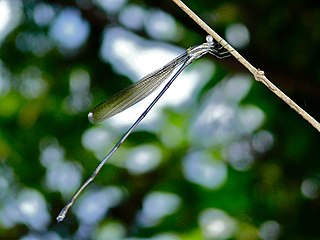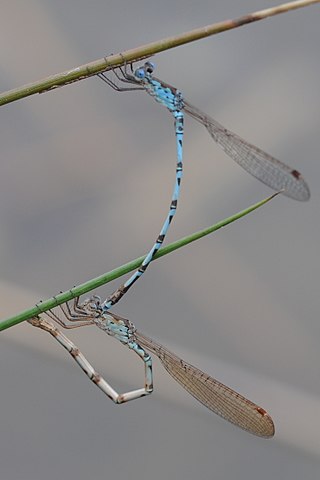
The insect family Coenagrionidae is placed in the order Odonata and the suborder Zygoptera. The Zygoptera are the damselflies, which although less known than the dragonflies, are no less common. More than 1,300 species are in this family, making it the largest damselfly family. The family Coenagrionidae has six subfamilies: Agriocnemidinae, Argiinae, Coenagrioninae, Ischnurinae, Leptobasinae, and Pseudagrioninae.

The Pseudostigmatidae are a family of tropical damselflies, known as helicopter damselflies, giant damselflies, or forest giants. The family includes the largest of all damselfly species. They specialize in preying on web-building spiders, and breed in phytotelmata, the small bodies of water held by plants such as bromeliads.

Mecistogaster is a genus of large Neotropical damselflies in the family Coenagrionidae, commonly known as helicopter damsels. There are eleven species distributed from Mexico to Argentina.

The Lestoideidae are a family of damselflies occurring in South-east Asia, New Guinea and Australia. The family comprises two genera and nine species.

Diphlebia is a genus of damselflies in the family Lestoideidae. They are commonly known as rockmasters. These damselflies are very large and thick. The species in this genus are found in Eastern Australia, except for one species that can be found in New Guinea. The males are vividly patterned. They are blue or bluish green and black in colour. Their blue colour also gives them the name azure damselflies. They rest with their wings spread out. Their wings are usually blackish brown or have white markings. These damselflies have several present antenodal crossveins. The two basal crossveins extend across costal and subcostal spaces. The larvae are wide and flat. They have long saccoid gills enabling them to breathe underwater. The inner tooth of their labial palps is elongated. The specific characters of the larvae are mid-ventral, distal width, basal width, and length of median lobe.
Philoganga is a genus of damselflies, the only genus in the family Philogangidae.

Diphlebia euphoeoides, sometimes spelled Diphlebia euphaeoides, known as the tropical rockmaster, is an Australian species of broad winged damselfly. It is one of a group known as the azure damselflies. It is found in Queensland (Australia) and Papua New Guinea. It typically occurs near lakes, waterfalls or streams at relatively low altitudes, and is occasionally seen near dry pools.

Microstigma rotundatum, the helicopter damselfly, is a species of damselfly belonging to the family Coenagrionidae.

Lestoidea is a genus of damselflies in the family Lestoideidae, commonly known as bluestreaks. Its species are endemic to north-east Queensland, Australia, where they inhabit rainforest streams.

Lestoidea is a superfamily of damselflies of the order Odonata.
Perilestes is a genus of damselflies in the family Perilestidae. There are about eight described species in Perilestes.

Perissolestes is a genus of damselflies in the family Perilestidae. There are about 12 described species in Perissolestes.
Mecistogaster buckleyi is a species of damselfly in the family Coenagrionidae. It is found in South America.

Mecistogaster lineari, or the giant helicopter damselfly, is a species of narrow-winged damselfly in the family Coenagrionidae. It is found in South America.

Mecistogaster lucretia is a species of narrow-winged damselfly in the family Coenagrionidae. It is found in South America.

Mecistogaster modesta is a species of narrow-winged damselfly in the family Coenagrionidae. It is found in Central America.

Mecistogaster ornata, the lemon-tipped helicopter, or ornate helicopter, is a species of narrow-winged damselfly in the family Coenagrionidae. It is found in Central America and South America.
Mecistogaster jocaste is a species of damselfly in the family Coenagrionidae. It is found in South America.